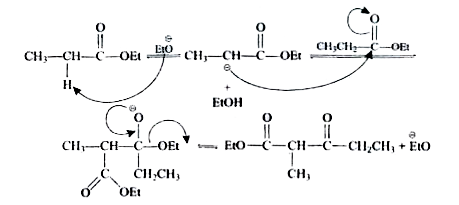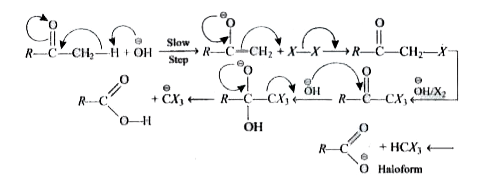CH3−O∣∣C−CH3X2−−→OHɵCHX3+CH3−O∣∣C−Oɵ
The rate of haloform reaction reaction is fastest with
X2=Cl2
X2=Br2
X2=I2
All at same rate rCl2=rBr2=rI2
The correct Answer is:D
To solve the question regarding the rate of the haloform reaction, we need to understand the mechanism and factors affecting the reaction rate. Here’s a step-by-step solution:
Step 1: Understand the Haloform Reaction
The haloform reaction involves the conversion of a methyl ketone (such as acetone) into a haloform (like iodoform, chloroform, or bromoform) in the presence of halogens (X₂) and a base (like NaOH). The general reaction can be represented as:
RCOCH3+3X2+4NaOH→RCOONa+3NaX+CHX3+3H2O
Step 2: Identify the Rate Determining Step
In the haloform reaction, the rate-determining step is the formation of the enolate ion from the ketone. This step is crucial because it determines how quickly the reaction proceeds.
Step 3: Analyze the Role of Halogens
The rate of the haloform reaction does not depend on the concentration of halogens (X₂). This means that whether we use chlorine (Cl₂), bromine (Br₂), or iodine (I₂), the rate of enolate formation remains the same.
Step 4: Compare the Reactivity of Halogens
While the rate of the reaction is independent of halogen concentration, the reactivity of the halogens does play a role in the overall reaction. Iodine is generally more reactive in the haloform reaction compared to chlorine and bromine due to the stability of the iodoform product (CHI₃) and the lower bond dissociation energy of the I-I bond.
Step 5: Conclusion
Given that the rate-determining step is the formation of the enolate ion and that the reactivity of the halogens does not affect this step, the fastest reaction will be with the halogen that forms the most stable haloform product. In this case, the reaction is fastest with iodine (I₂) because it forms iodoform (CHI₃), which is a stable product.
Final Answer
The rate of the haloform reaction is fastest with iodine (I₂).
---
The haloform reaction involves the conversion of a methyl ketone (such as acetone) into a haloform (like iodoform, chloroform, or bromoform) in the presence of halogens (X₂) and a base (like NaOH). The general reaction can be represented as:
In the haloform reaction, the rate-determining step is the formation of the enolate ion from the ketone. This step is crucial because it determines how quickly the reaction proceeds.
The rate of the haloform reaction does not depend on the concentration of halogens (X₂). This means that whether we use chlorine (Cl₂), bromine (Br₂), or iodine (I₂), the rate of enolate formation remains the same.
While the rate of the reaction is independent of halogen concentration, the reactivity of the halogens does play a role in the overall reaction. Iodine is generally more reactive in the haloform reaction compared to chlorine and bromine due to the stability of the iodoform product (CHI₃) and the lower bond dissociation energy of the I-I bond.
Given that the rate-determining step is the formation of the enolate ion and that the reactivity of the halogens does not affect this step, the fastest reaction will be with the halogen that forms the most stable haloform product. In this case, the reaction is fastest with iodine (I₂) because it forms iodoform (CHI₃), which is a stable product.
The rate of the haloform reaction is fastest with iodine (I₂).
Similar Questions
Knowledge Check
- Question 1 - Select One
Compound having −O∣∣C−CH3 group reacts rapidly with halogen in presence of a base to form haloform. The reaction is known as haloform.
R−O∣∣C−CH3X2+ϴOH−−−−→R−O∣∣C−ϴO+CHX3
Mechanism

Consider the following reactions:
Reaction I →Ph−O∣∣C−CH3Cl2,ϴOH−−−−→Ph−O∣∣C−ϴO+CHCl3
Reaction II →Ph−O∣∣C−CD3−Cl2,ϴOH−−−−→Ph−O∣∣C−ϴO+CDCl3
Which of the following is correct comparison of the rate of reaction I and II?ArI>rIIBrI>rIICrI=rIIDCannot be determined - Question 2 - Select One
When two molecules of an ester undergo a condensation reaction, the reaction is called a Claisen condensation. The product of a claisen condensation is β ketoester.
2CH3CH2−O∣∣C−OEt1.CH3CH2ϴO−−−−−−−−−−→2.H⊕CH3CH2−O∣∣C−C∣CH3H−O∣∣C−OEt+EtOH
Mechanism:

Find out final product of reaction: br>
Y isA B
B C
C D
D
- Question 3 - Select One or More
Compound having −O∣∣C−CH3 group reacts rapidly with halogen in presence of a base to form haloform. The reaction is known as haloform.
R−O∣∣C−CH3X2+ϴOH−−−−→R−O∣∣C−ϴO+CHX3
Mechanism


Which of the following is correct comparisonof rate of haloform reaction with various halogens?ArCl2>rBr2>rI2BrI2>rBr2>rCl2CrCl2=rBr2=rI2DrBr2>rCl2>rI2
Ph−O∣∣C−CH3+CH2=O(excess)OHΘ−−→Ph−O∣∣C−C(CH2OH)3
In the above reaction how times of aldol reaction takes place ?View SolutionThe IUPAC name of
CH3−O∣∣C−CH2−OH∣CH−CHO
isView SolutionThe IUPAC name of
CH3−O∣∣C−CH2−OH∣CH−CHO
isView SolutionCH3−CH2−O∣∣C−CH3∣C∣CH3−CH3PhCO3H−−−−−→A,A will be
View SolutionWhat is the given reaction known as?
CH3−O∣∣C−CH3C6H5CO3H−−−−−−→CH3−O∣∣C−O−CH3View Solution

